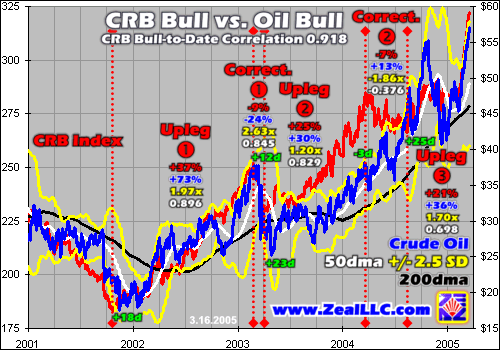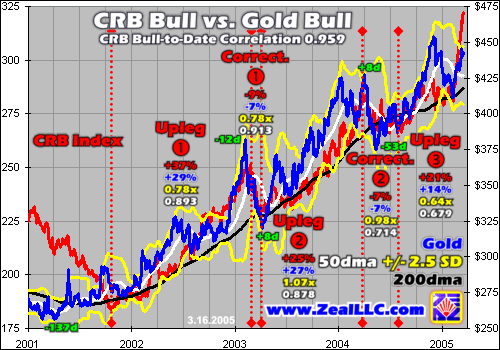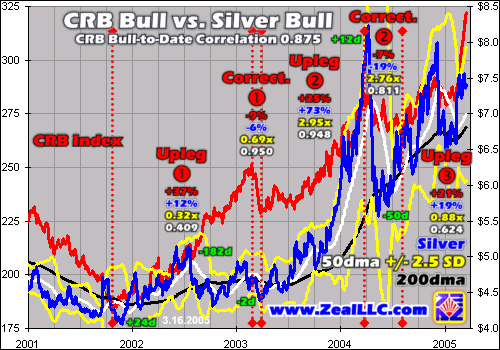|
|
|||||||
|
|
|
|
|
|
|
|
|
|
Trading with the CRB Adam Hamilton March 18, 2005 2861 Words
In last week’s essay I discussed the magnificent breakout of the CRB Commodities Index back above 300 for the first time in 24 years. I also delved into the concept of the Relative CRB as a trading tool for futures speculators gaming the CRB directly.
As I was digesting all of the excellent feedback that folks graciously sent in, a thesis that kept popping up was the idea of using the CRB index as some kind of trading indicator for individual commodities. For example, can we as speculators watch the CRB itself for important technical clues as to when high-probability-for-success trades exist in individual commodities like oil?
This idea really intrigues me as well so I thought I would take a look at it this week. Comparative market analysis, using other markets to help determine the probable direction of the primary market being studied, can be very valuable. A great example is using the short-term machinations of the dollar and euro to help forecast probable near-term gold action.
While using the CRB as a technical indicator for trading individual commodities is an interesting concept, unfortunately the odds are stacked against it working due to the way the CRB index is calculated. The CRB custodians go to great lengths to smooth out volatility in the 17 individual commodities that currently make up the index.
Individual commodities are arithmetically averaged across their various futures contracts that expire in the coming six months. After this operation is done for all 17 commodities, all 17 simple average prices are then geometrically averaged. All the individual simple average commodity prices are multiplied and then the 17th root is taken, yielding a geometric average across all components.
Finally this geometric average result obtained from the 17th root is divided by a 1967 base-year average for commodities prices and multiplied by 100. The end result of these dual averages over time in individual commodities and across all commodities is a stalwart index that is the most resistant to component volatility out of any other major index that I have ever studied.
This heavy mathematical smoothing is why I was so excited last week to see the CRB surge so dramatically from support to resistance like a rocket. In just five weeks the venerable index has catapulted from 281 to 322, a phenomenal and very out-of-character 15% gain! Such a sharp spike would be notable in any broad index, but in a geometrically averaged one it is truly extraordinary.
One or two commodities alone are not enough to move a geometric index so rapidly. Coffee, cocoa, orange juice, cotton, wheat, corn, soybeans, natural gas, heating oil, and crude oil all contributed to this latest stupendous five-week rise in the CRB. This list of surging commodities includes 10 of the CRB 17, more than enough to push it higher. The metals, of course, are conspicuous in their absence.
Due to the geometric weighting employed, if gold or silver had fallen sharply in the past five weeks their declines would barely even have dented the CRB surge. Any one component commodity, moving in any direction, will have a minimal impact on the headline CRB due to the dual averaging process. Thus, even before we embark it is mathematically unlikely that the CRB will prove to be a useful technical indicator for trading individual commodities.
Nevertheless, a lower probability of success does not mean that specific financial research should not be undertaken. Sometimes the numbers have a way of surprising and valuable insight can spring from even the most ill-fated research project.
As I mentioned last week, oil, gold, and silver are the big three commodities for investment and speculation, either directly via futures and physical or indirectly by buying leveraged producers of these key commodities. A few other commodities like copper, platinum, and natural gas can be played indirectly by buying stocks, but most of the CRB 17 are not really conducive to stock investment.
Wheat production, for example, is highly fragmented with countless millions of small farmers around the world raising it. Finding a major leveraged wheat-producer stock, if they actually exist, is vastly harder than finding a major copper producer. The metal and energy commodities are much easier to invest in indirectly since they have huge upfront capital costs that only big publicly-traded corporations can afford. Most of the agricultural commodities have low barriers to entry and are too fragmented for stock investment.
While futures traders can play all CRB commodities directly, futures accounts are only a small fraction of total investment accounts today. With big leverage and the ever-present risk of losing more capital than you initially bet, futures trading is not for everyone. In addition, the futures markets are far more efficient than stocks since futures traders are usually professionals who only concentrate on a handful of contracts.
Stocks, on the other hand, tend to be very inefficient with endless streams of speculators, professional and amateur, finding their attention diverted by thousands of stocks from which to pick. In general, the greatest profit potential lies in the least efficient market, in this case equities. Futures are great if you put a decade or more into understanding this unforgiving realm, but for general investors stocks are easier, less risky (you can’t lose more than your initial bet), and less efficient (more undiscovered opportunities for large profits).
In order to gain an understanding of how major turning points in oil, gold, and silver compared to the CRB, we overlaid three identical CRB charts from last week with the individual commodity data. The CRB is drawn in red in all these charts, slaved to the left axis. If you would like a better look at the CRB alone for reference without the individual commodity overlays, please check out the second chart from last week.
I focused on two specific areas to research the CRB-as-an-individual-commodity-indicator thesis, offsets and individual commodity performance during the CRB’s major uplegs and corrections in this CRB bull to date.
The offsets, noted below in green, show how many days before or after a major CRB interim reversal that the individual commodities mirrored the great trading opportunity. In late 2001, for example, crude oil had an offset of +18 trading days from the CRB’s own interim bottom. This means that oil bottomed 18 days after the CRB. Positive offsets denote trading days after the CRB’s major turns while negative offsets note trading days before.
Individual commodity offsets are important as they show how likely an individual commodity is to experience a major tradable interim high or low close to those of the underlying CRB itself. The closer the average offsets for an individual commodity happen to be, the higher the probability that the CRB may be a useful trading indicator for that particular commodity.
The second thing I looked at is individual commodity performance relative to the CRB over the exact dates marking major CRB uplegs and corrections. The CRB has had three major uplegs and two major corrections so far bull to date. If the CRB is going to be a useful individual commodity trading indicator, then the index’s own major moves ought to mark similarly profitable moves in the individual commodities.
In these charts, under each major CRB upleg and correction four numbers are noted. The first red one is the CRB’s actual performance in that particular major move. The second blue one is the individual commodity’s performance over the identical date range to the CRB’s major move. The third yellow number shows the individual commodity’s leverage relative to the CRB. For example, if the CRB went up 10% but the commodity went up 20%, then it would have 2.00x leverage.
The final white number notes the correlation coefficient between the CRB and the individual commodities during each of the CRB’s major moves. Generally the higher the individual commodity and the CRB are correlated on average the higher the probability that the CRB may prove to be a useful technical indicator for that particular commodity.
We’ll analyze oil, gold, and silver relative to the CRB in the order of their relative risk and potential returns. Oil is the least risky of these three elite commodities with the lowest expected returns. Silver is the most risky with the highest expected returns. Gold lies somewhere in the middle. Generally the smaller an individual commodity’s market, the greater its potential volatility and returns.
Over a secular timeframe, since their respective bulls launched in late 2001, oil and the CRB have had a high correlation of 0.918. This leads to an r-square value suggesting that 84% of the daily moves in oil can be explained by the CRB’s behavior, or vice versa. When the CRB is in a bull market, oil ought to be as well as the recent years have proven.
Interestingly, however, on the tactical trading scale the correlation of oil and the CRB over the CRB’s individual uplegs was far weaker at an average of only 0.578. This means that only 33% of the daily moves in oil in an average individual upleg or correction are explainable by corresponding moves in the CRB. Thus, the long-term oil correlation with the CRB is high but it rapidly breaks down over shorter trading timespans.
The average absolute value of the oil interim reversal offsets to the CRB interim reversals confirms the fact that oil and the CRB don’t tend to turn at exactly the same time. On average, a major interim top or bottom in crude oil can be expected within +/- 16 trading days of a major interim top or bottom in the CRB. This offset is probably fine for long-term secular investors, but it is pretty sloppy for short-term speculators looking to ride trends for a year or less.
Another problem arises when the CRB’s second major correction in 2004 is considered. During this time the CRB retreated 7%, a typical correction, but oil was relatively strong clawing up 13% over the exact same period of time. In addition the CRB’s current upleg, number three, has only witnessed an oil/CRB correlation of 0.698 so far, not very impressive. Thus the CRB’s relationship to oil seems to be weakening as time marches on.
In light of these observations, I think investors interested in holding for over a year can gain some insight into the general probability of major interim crude oil bottoms by watching the CRB technicals. If the CRB is near its technical support line, then oil should be approaching its own support as well.
Short-term speculators, on the other hand, will probably not be well served by a CRB indicator for oil that has a six-week margin for error on major long and short signals as well as deteriorating correlations as of late. Trading oil with the CRB appears to be far less efficient than trading oil based on oil technicals alone.
Oil theoretically contributes to 1/17th of the CRB’s major moves, but its topping and bottoming timing is not very precise when viewed through the lens of the CRB. Is gold any better?
Out of all three elite commodities, gold’s correlation with the CRB is the highest by far at 0.959 bull to date. This suggests that over a secular timeframe 92% of gold’s daily moves can be explained by the CRB’s daily machinations. While this certainly sounds good from a strategic perspective, once again during tactical trading timespans it is definitely found wanting.
Looking at the average absolute offset between gold and the CRB around major interim trend changes, the CRB does not correspond well with major gold trading signals at all. At +/- 44 trading days either way, the CRB can carve a major interim top or bottom months away from the corresponding interim reversal in gold. Even recently, in mid-2004, gold bottomed a whopping 53 trading days before the CRB’s corresponding bottom.
Interestingly, in raw performance terms, gold’s average leverage to the CRB during its major uplegs and corrections was only 0.85x that of the CRB. If you are a futures speculator trying to decide whether to play the CRB directly or play gold, this is interesting food for thought. Gold’s returns may still prove to be higher though if they are measured from gold’s own major interim reversals instead of the CRB’s.
Gold’s average correlation with the CRB during its major intermediate moves only ran 0.815, for an r-square value of just 66%. Thus, gold does not seem to mirror the CRB to any great degree in terms of the timing of its intermediate tops and bottoms.
Much like oil, a CRB index near its major support can help announce that the season is right for gold to bottom, but it really can’t offer a high-probability time with any real precision. This is useful for investors wanting to buy and hold for a few years or more, but not as valuable to short-term traders.
As a gold speculator, to me it doesn’t look like the CRB has high potential to be a subsidiary technical indicator for gold. I would much rather use pure gold-based indicators as well as look at gold relative to its competing major currencies the dollar and euro. Just like it did for oil the CRB tends to be generally high or generally low along with gold, but specific tradable bottoms and tops in the CRB just don’t correspond closely enough with those of gold.
Our final chart this week takes a look at silver relative to the CRB, which is already a problematic comparison since the silver bull started in earnest about 18 months after the general commodities bull. As such, silver’s overall daily correlation with the CRB bull to date is only 0.875, really fairly low as far as indicators go. Only 77% of silver’s daily price moves may be explainable by the CRB action since 2001.
Silver’s offsets away from major interim tops and bottoms in the CRB are also all over the map, having an absolute-value average of 54 days, the highest by far out of all three elite commodities. Its average correlation between all the CRB’s major uplegs and corrections was only 0.748, again pretty low. Like oil and gold silver has a decent general correlation with the commodities bull, but the CRB doesn’t seem to provide tradable cues on silver specifically.
In light of this cursory analysis, it looks like the intriguing prospect of building a technical indicator out of the CRB that can give trading signals in major individual component commodities does not have a high probability for success. The CRB does tend to mirror general strong and weak seasons in oil, gold, and silver fairly well, but the actual dates of major interim trend changes are all over the map.
Due to its aggressive across-time simple average individual commodity prices and across-commodities geometric averaging, the CRB is simply not very responsive to any of its individual components. On average, less than 6% of the CRB’s behavior is contributed by any individual commodity. Thus if oil or gold are soaring but the grains and meats are not, the CRB will more accurately reflect the lion’s share of its components’ trends rather than the outliers.
While it is a bit disappointing that a technical trading indicator for individual commodities derived from the CRB was not more forthcoming, the design of the CRB is not a bad thing at all. Its careful construction and heavy smoothing operations combine to form a very unbiased view of the commodities bull in general. The CRB will move higher only if the majority of its components are moving higher as well. It simply can’t rise significantly mathematically if only one or two of the CRB 17 are thriving.
Thus if you usually traffic in the oil, gold, or silver worlds, but you want to peek out of the melee to see how commodities in general are doing, the CRB index is the perfect place to look. It paints a beautiful and clear strategic picture of commodities in general, and its volatility-choking construction ensures that it is a fair representation of the majority of commodities rather than only the hot ones at the moment.
At Zeal we have been actively trading this Great Commodities Bull of the 00s as well as developing innovative technical indicators since its earliest days. While the CRB doesn’t have much precision in calling tops and bottoms in individual commodities, many of our other indicators certainly do. If you would like to mirror our own actual trades in elite leveraged oil, gold, and silver producers when the probabilities seem highly in our favor, please join us today.
The bottom line is the CRB index is a great strategic measuring rod that is probably all but impossible to manipulate based on its heavily-smoothed construction. It deftly proves that we are running in a glorious broad-based commodities bull, not just individual bulls in oil, gold, silver, or other market-darling commodities.
But the CRB’s very strategic nature makes it inappropriate for the construction of a tactical trading indicator to precisely time trades in its individual component commodities. All the averaging and smoothing it does simply renders the influence of any individual commodity too immaterial to matter.
Adam Hamilton, CPA March 18, 2005 Subscribe |
|||||||
|
|
|
|
|
|
|
|
|
|
|
|
|
|
|
|||



